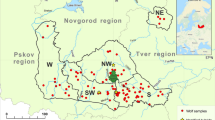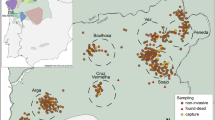Abstract
A population of grey wolvesCanis lupus Linnaeus, 1758 inhabiting Białowieża Primeval Forest (BPF) on the Polish-Belarussian border has recovered after near extermination in the 1970s. Currently, it is intensively hunted in the Belarussian part of BPF and protected in the Polish part. We used a combination of molecular analysis, radiotracking, and field observation to study genetic diversity of the population after natural recolonisation and the consequences of heavy hunting for the genetic composition and social structure of wolf packs. Both microsatellite and mtDNA analyses revealed high genetic diversity. For 29 individuals and 20 microsatellite loci, the mean expected heterozygosity was 0.733. Four mtDNA haplotypes were found. Three of them had earlier been described from Europe. Their geographic distribution suggests that wolves recolonising BPF immigrated mainly from the north-east, and less effectively from the east and south-east. We traced the composition of 6 packs for a total of 26 pack-years. Packs were family units (a breeding pair with offspring) with occasional adoption of unrelated adult males, which occurred more frequently in packs living in the Belarussian part of the BPF, due to heavy hunting and poaching. Breeding pairs were half-sibs or unrelated wolves. Pair-bonds in the breeding pair lasted from 1 to 4 years and usually broke by the death of one or both mates. Successors of breeding females were their daughters, while a successor of a breeding male could be either his son or an alien wolf. As is evident from Białowieża’s wolves, high genetic diversity may result from immigration of outside individuals, which are easily recruited to a heavily exploited local population.
Similar content being viewed by others
References
Andersone Z., Lucchini V., Randi E. and Ozolins J. 2002. Hybridisation between wolves and dogs in Latvia as documented using mitochondrial and microsatellite DNA markers. Mammalian Biology 67: 97–90.
Caughley G. 1996. Conservation biology in theory and practice. Blackwell Science, Cambridge, MA.
Ciucci P. and Boitani L. 1991. Viability assessment of the Italian wolf and guidelines for the management of the wild and a captive population. Ricerche di Biologia della Selvaggina 89: 1–58. [In Italian with English summary]
Ellegren H. 1999. Inbreeding and relatedness in Scandinavian grey wolvesCanis lupus. Hereditas 130: 239–244.
Ellegren H., Savolainen P. and Rosen B. 1996. The genetical history of an isolated population of the endangered grey wolfCanis lupus: as tudy of nuclear and mitochondrial polymorphisms. Philosophical Transactions of the Royal Society, London, B 351: 1661–1669.
Faliński J. B. 1986. Vegetation dynamics in temperate lowland primeval forests. Ecological studies in Białowieża Forest. Dr W. Junk Publishers, Dordrecht, Holland: 1–537.
Flagstad Ø., Walker C. W., Vila C., Sundqvist A.-K., Fernholm B., Hufthammer A. K., Wiig Ø., Koyola I. and Ellegren H. 2003. Two centuries of the Scandinavian wolf population: patterns of genetic variability and migration during an era of dramatic decline. Molecular Ecology 12: 869–880.
Forbes S. H. and Boyd D. K. 1996. Genetic variation of naturally colonising wolves in the Central Rocky Mountains. Conservation Biology 10: 1082–1090.
Francisco L. V., Langston A. A., Mellersh C. S., Neal C. L. and Ostrander E. A. 1996. A class of highly polymorphic tetranucleotide repeats for canine genetic mapping. Mammalian Genome 7: 359–362.
Fredholm M. and Wintero A. K. 1995. Variation of short tandem repeats within and between species belonging to the Canidae family. Mammalian Genome 6: 11–18.
Fritts S. H. and Mech L. D. 1981. Dynamics, movements, and feeding ecology of a newly protected wolf population in north-western Minnesota. Wildlife Monographs 80: 5–79.
Guo S. and Thompson E. 1992. Performing the exact test of Hardy-Weinberg proportion for multiple alleles. Biometrics 48: 361–372.
Jędrzejewska B. and Jędrzejewski W. 1998. Predation in vertebrate communities. The Białowieża Primeval Forest as a case study. Springer, Berlin, Germany: 1–450.
Jędrzejewska B., Jędrzejewski W., Bunevich A. N., Miłkowski L. and Okarma H. 1996. Population dynamics of wolvesCanis lupus in Białowieża Primeval Forest (Poland and Belarus) in relation to hunting by humans, 1847–1993. Mammal Review 26: 103–126.
Jędrzejewski W., Jędrzejewska B., Okarma H., Schmidt K., Zub K. and Musiani M. 2000. Prey selection and predation by wolves in Białowieża Primeval Forest, Poland. Journal of Mammalogy 81: 197–212.
Jędrzejewski W., Schmidt K., Theuerkauf J., Jędrzejewska B., Selva N., Zub K. and Szymura L. 2002. Kill rates and predation by wolves on ungulate populations in Białowieża Primeval Forest (Poland). Ecology 83: 1341–1356.
Jędrzejewski W., Schmidt K., Jędrzejewska B., Theuerkauf J., Kowalczyk R. and Zub K. 2004. The process of a wolf pack splitting in Białowieża Primeval Forest, Poland. Acta Theriologica 49: 275–280.
Lehman N., Eisenhawer A., Hansen K., Mech L. D., Peterson R. O., Gogan P. J. P. and Wayne R. K. 1991. Introgression of coyote mitochondrial DNA into sympatric North American gray wolf populations. Evolution 45: 104–119.
Lehman N., Clarkson P., Mech L. D., Meier T. J. and Wayne R. K. 1992. A study of the genetic relationships within and among wolf packs using DNA fingerprinting and mitochondrial DNA. Behavioural Ecology and Sociobiology 30: 83–94.
Lorenzini R. and Fico R. 1995. A genetic investigation of enzyme polymorphism shared by wolf and dog: suggestions for conservation of the wolf in Italy. Acta Theriologica, Suppl. 3: 101–110.
Lucchini V., Galov A. and Randi E. 2004. Evidence of genetic distinction and long-term population decline in wolves (Canis lupus) in the Italian Apennines. Molecular Ecology 13: 523–536.
Marshall T. C., Slate J., Kruuk L. and Pemberton J. M. 1998. Statistical confidence for likelihood-based paternity inference in natural populations. Molecular Ecology 7: 639–655.
Meier T. J., Burch J. W., Mech L. D. and Adams L. G. 1995. Pack structure and genetic relatedness among wolf packs in a naturally-regulated population. [In: Ecology and conservation of wolves in a changing world, L. N. Carbyn, S. H. Fritts, D. R. Seip, eds]. Canadian Circumpolar Institute, University of Alberta, Edmonton: 293–302.
Nei M. 1978. Estimation of average heterozigosity and genetic distance from a small number of individuals. Genetics 89: 583–590.
Okarma H. and Jędrzejewski W. 1997. Livetrapping wolves with nets. Wildlife Society Bulletin 25: 78–82.
Okarma H., Jędrzejewski W., Schmidt K., OEnieżko S., Bunevich A. N. and Jędrzejewska B. 1998. Home ranges of wolves in Białowieża Primeval Forest, Poland, compared with other Eurasian populations. Journal of Mammalogy 79: 842–852.
Paetkau D., Slade R., Burdens M. and Estoup A. 2004. Genetic assignment methods for the direct, real-time estimation of migration rate: a simulation-based exploration of accuracy and power. Molecular Ecology 13: 55–65.
Piry S., Alapetite A., Cornuet J.-M., Paetkau D., Baudouin L. and Estoup A. 2004. GeneClass2: a software for genetic assignment and first-generation migrants detection. Journal of Heredity 95: 536–539.
Promberger C. and Schröder W. (eds) 1992. Wolves in Europe — Status and perspectives. Proceedings of the workshop, Oberammergau, Germany, 2–5 April, 1992. Munich Wildlife Society, Germany: 1–132.
Queller D. C. and Goodnight K. F. 1989. Estimating relatedness using genetic markers. Evolution 43: 258–275.
Randi E., Lucchini V., Christensen M. F., Mucci N., Funk S. M., Dolf G. and Loeschcke V. 2000. Mitochondrial DNA variability in Italian and East European wolves: detecting the consequences of small population size and hybridization. Conservation Biology 14: 464–473.
Randi E. and Lucchini V. 2002. Detecting rare introgression of domestic dog genes into wild wolf (Canis lupus) populations by Bayesian admixture analyses of microsatellite variation. Conservation Genetics 3: 31–45.
Rannala B. and Mountain J. L. 1997. Detecting immigration by using multilocus genotypes. Proceedings of the National Academy of Sciences (USA) 94: 9197–9221.
Raymond M. and Rousset F. 1995. GENEPOP (version 1.2): population genetics software for exact tests and ecumenicism. Journal of Heredity 86: 248–249.
Roy M. S., Geffen E., Smith D., Ostander E. A. and Wayne R. K. 1994. Patterns of differentiation and hybridization in North American wolflike canids, revealed by analysis of microsatellite loci. Molecular Biology and Evolution 11: 553–570.
Sambrook J., Fritsch E. F. and Maniatis T. 1989. Molecular cloning: A laboratory manual. 2nd edition. Cold Spring Harbor Press, New York.
Savolainen P., Rosen B., Holmberg A., Leitner T., Uhlen M. and Lundeberg J. 1997. Sequence analysis of domestic dog mitochondrial DNA for forensic use. Journal of Forensic Science 42: 593–600.
Schneider S., Roessli D. and Excoffier L. 2000. ARLEQUIN version 2.0. A software for population genetics data analysis. Genetics and Biometry Laboratory, University of Geneva.
Tsuda K., Kikkawa Y., Yonekawa H. and Tanable Y. 1997. Extensive interbreeding occurred among multiple matriarchal ancestors during the domestication of dogs: evidence from inter- and intraspecies polymorphism in the D-loop region of mitochondrial DNA between dogs and wolves. Genes and Genetic Systems 72: 229–238.
Vila C., Savolainen P., Maldonado J. E., Amorim I. R., Rice J. E., Honeycutt R. L., Crandall K. A., Lundeberg J. and Wayne R. K. 1997. Multiple and ancient origin of the domestic dog. Science 276: 1687–1689.
Vila C., Amorim I. R., Leonard J. A., Posada D., Castroviejo J., Petrucci-Fonseca F., Crandall K. A., Ellegren H. and Wayne R. K. 1999. Mitochondrial DNA phylogeography and population history of the grey wolfCanis lupus. Molecular Ecology 8: 2089–2103.
Vila C., Sundqvist A.-K., Flagstad Ø., Seddon J., Bjornerfeldt S., Kojola I., Casulli A., Sand H., Wabakken P. and Ellegren H. 2003. Rescue of a severely bottlenecked wolf (Canis lupus) population by a single immigrant. Proceedings of the Royal Society of London B 270: 91–97.
Author information
Authors and Affiliations
Additional information
Associate Editor was Andrzej Zalewski.
Rights and permissions
About this article
Cite this article
Jędrzejewski, W., Branicki, W., Veit, C. et al. Genetic diversity and relatedness within packs in an intensely hunted population of wolvesCanis lupus . Acta Theriol 50, 3–22 (2005). https://doi.org/10.1007/BF03192614
Received:
Accepted:
Issue Date:
DOI: https://doi.org/10.1007/BF03192614




